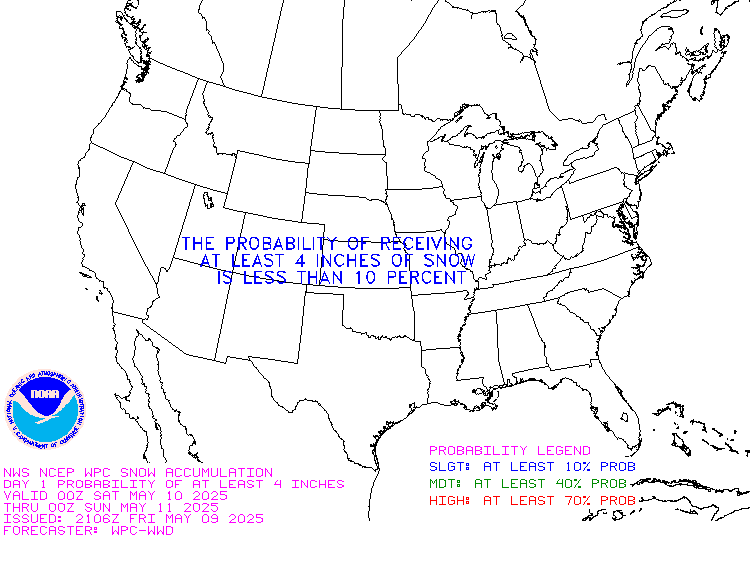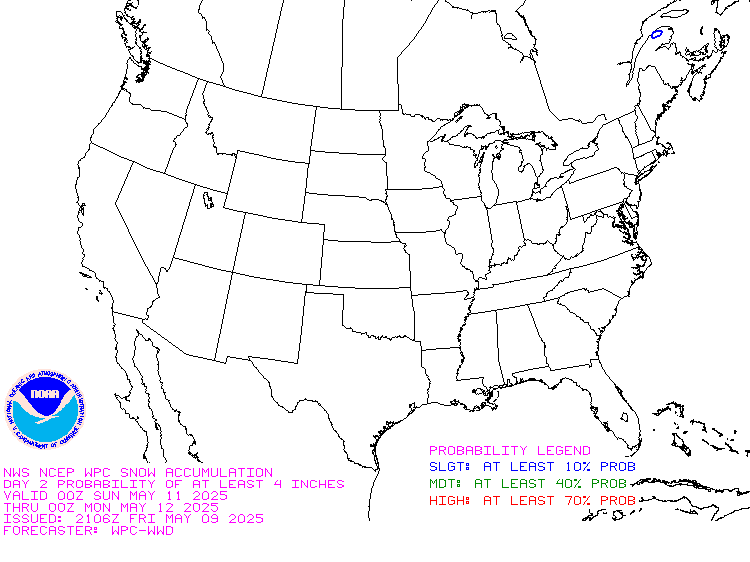[Note that at the time of publication some NOAA websites seemed to not be working. The NWS text forecast is working. One can find the U.S. forecast in the international forecasts since the U.S. is part of the world.]
It is difficult to find a more comprehensive Weather Outlook anywhere else with the ability to get a local 10-day Forecast also.
This article focuses on what we are paying attention to in the next 48 to 72 hours. The article also includes weather maps for longer-term U.S. outlooks and a six-day World weather outlook which can be very useful for travelers.
First the NWS Short Range Forecast. The afternoon NWS text update can be found here but it is unlikely to have changed very much. The images in this article automatically update.
Short Range Forecast Discussion
NWS Weather Prediction Center College Park MD
Tue Apr 16 2024
Valid 12Z Tue Apr 16 2024 – 12Z Thu Apr 18 2024…Storm system to bring the threat of severe weather and isolated flash
flooding to the Mississippi Valley Tuesday and the Lower Great Lakes/Ohio
Valley on Wednesday……Moderate to locally heavy snowfall expected over the next couple of
days for the northern Rockies……Warm temperatures continue across the South and Desert Southwest,
chillier weather expected for the Upper Great Lakes and northern Rockies…A seasonably strong low pressure/frontal system over the central U.S. will
move from the Plains into the Mississippi Valley during the day Tuesday. A
sustained arc of showers and thunderstorms wrapping around the low over
the Northern Plains into the Upper Midwest this morning will continue to
progress to the northeast, with more scattered storms extending southward
through the central/southern Plains along an eastward advancing cold
front. A renewed round of storms is expected along and ahead of the cold
front Tuesday afternoon. Strong deep-layer and low-level shear along with
more than sufficient buoyancy will be available in the warm sector for
robust supercell development. The Storm Prediction Center has issued an
Enhanced Risk of Severe Weather (level 3/5) for portions of southern Iowa,
northeastern Missouri, and far western Illinois where these storms will
pose a threat for very large hail, damaging winds, and tornadoes,
including the risk for a strong tornado. A broader Slight Risk (level 2/5)
extends southward through Missouri into northern Arkansas where a more
isolated threat for storms will exist, but will still pose the threat for
all hazards. In addition to severe weather, rounds of heavy rainfall from
the more widespread storms over the Upper Midwest along with potentially
more scattered but heavier downpours with storms to the south through the
Middle Mississippi Valley will pose a threat for some isolated flash
flooding.The system will continue eastward on Wednesday into the Great Lakes region
and Ohio Valley. Similar to Tuesday, storms will likely be ongoing
overnight Tuesday into early Wednesday, especially to the north from the
Upper Midwest into the Great Lakes. Some scattered storms may also
continue along the cold front as it pushes into the Ohio Valley. A renewed
round of storm development is expected ahead of the front by Wednesday
afternoon, with a Slight Risk of severe weather in place from eastern
Indiana into southern Michigan and western Ohio for the threat of large
hail, damaging winds, and a few tornadoes. The storms are forecast to
continue overnight Wednesday into the Mid-Atlantic. Again, similar to
Tuesday, more widespread rainfall over the Great Lakes and the potential
for some more potent downpours with storms further south will pose a
threat for some isolated flash flooding.To the West, another upper-level trough/associated surface frontal system
pushing southeastward through the northern Rockies will bring the chance
for some moderate to locally heavy snow for higher elevations in the
mountains of Montana Tuesday and into Wyoming by Wednesday morning. Winter
weather-related advisories and warnings are in place for snow
accumulations generally between 6-12″, with higher amounts more likely in
Wyoming. Some lighter snow showers will also be possible along the
trailing end of the frontal system over the northern Cascades Tuesday.
Otherwise, the remainder of the country will be mostly dry. Temperatures
will tend to generally be at or above average along the southern tier of
the country with cooler temperatures along the northern tier. Forecast
highs in the 80s are expected from the Southern Plains east through the
Southeast, with 70s and 80s for California and the Central Plains east
through the Ohio Valley, and 70s in the Mid-Atlantic. The warmest
temperatures will be over the Desert Southwest as highs climb into the
90s. To the north, 50s and 60s are expected for the Pacific Northwest,
Northern Plains, and New England. Areas of the Upper Great Lakes and
northern Rockies will see the coolest temperatures, with highs mainly in
the 40s by Wednesday.
To get your local forecast plus active alerts and warnings click HERE and enter your city, state or zip code.
Above is a 72 hour animation of the forecast. Learn about wave patterns HERE.
Then, looking at the world and of course, the U.S. shows here also. Today we are looking at precipitation.
Please click on “Read More” below to access the full Daily Report issued today.
| Notices: What would you like to learn about? Please provide that to me via the comment section at the end of the article. |
Now more detail on the 48-Hour Forecast (It is a 48 to 72 Hour Forecast actually)
Daily weather maps. The Day 1 map updates twice a day and the Day 2 and 3 maps update only once a day. These maps update automatically. But if that does not happen, you can get updates by clicking HERE
TODAY (or late in the day the evening/overnight map will appear) (Key to surface fronts shown on maps and you will then also be able to insert a city name or zip code and get a local NWS forecast).
TOMORROW
NEXT DAY
This animation shows how things may play out over the next 60 hours. To update click here.
The NWS Climate Prediction Center’s: Watches, Warnings, and Advisories plus other information can be found HERE. We post at least one of those updates daily, sometimes both. The Highlights are shown in the lede paragraph of this article.
ATMOSPHERIC RIVERS
This tells us what is approaching the West Coast. Click HERE to update If I have not gotten around to doing the update. Here is some useful information about Atmospheric Rivers.
Below is the current five-day cumulative forecast of precipitation (Updates can be found HERE)
Ski SnowReports
New Feature – Ski Reports. It is difficult to find reports that auto-update on-screen (and they are very long) but these links will get you to them – If you have additional suggestions make them in the comments section after every Econcurrents Article and we may add those links. We will try to not have too much overlap as that can add to the confusion.
Snow Forecasts. And remember this shows natural snow. Ski resorts also make their own snow.
Day 1

Day 2

Additional snow information can be found here, here, here, and here. The second link provides animations.
Now we look at Intermediate-Term “Outlook” maps for three time periods. Days 6 – 10, Days 8 – 14, and Weeks 3 and 4. An outlook differs from a forecast based on how NOAA uses these terms in that an “outlook” presents information as deviation from normal and the likelihood of these deviations.
Below are the links to obtain updates and additional information. They are particularly useful if you happen to be reading this article significantly later than when it was published. I always try to provide readers with the source of the information in my articles. These links may also be useful for those viewing this article on a cell phone or other small screen.
| Days 6 – 10 (shown in Row 1) | Days 8 – 14 (Shown in Row 2) | Weeks 3 and 4 (Shown in Row 3 but updates only on Fridays) |
| https://www.cpc.ncep.noaa. gov/products/predictions/610day/ | https://www.cpc.ncep .noaa.gov/products/predictions/814day/ | https://www.cpc.ncep.noaa.gov/products/predictions/WK34/ |
Showing the actual maps. They should now update automatically. The Week 3 – 4 Outlook only updates on Fridays. So below is what I call the Intermediate-term outlook. On Fridays, it extends out 28 Days. That declines day by day so on Thursday it only looks out 22 days until the next day when the Week 3 – 4 Outlook is updated and this extends the outlook by one additional week.
| 6–
10
|
|
|
| 8–
14 |
|
|
| 3–
4 |
|
|
HAZARDS OUTLOOKS
Click here for the latest complete Day 3 -7 Hazards forecast which updates only on weekdays. Once a week probably Monday or Tuesday I will update the images. I provided the link for readers to get daily updates on weekdays. Use your own judgment to decide if you need to update these images. I update almost all the images Friday Night for the weekend edition of this Weather Report. So normally readers do not need to update these images but if the weather is changing quickly you may want to.
Temperature month to date can be found at https://hprcc.unl.edu/products/maps/acis/MonthTDeptUS.png
Precipitation month to date can be found at https://hprcc.unl.edu/products/maps/acis /MonthPNormUS.png
World Forecast [that website is has been intermittent so be patient]
Below are the Day 1 -3 and 4-6 forecasts for temperature and precipitation. Updates and much additional information can be obtained HERE
World Temperature Anomalies
World Accumulated Precipitation
This information is provided by the University of Maine. They draw upon many different sources. There is a lot of information available at the link provided. I have just provided two useful forecasts. There are probably over a hundred different forecasts available from this source.
Worldwide Tropical Forecast (This is a NOAA Product)
This graphic updates on Tuesdays) If it has not been updated, you can get the update by clicking here Readers will only have to do that if they are reading this article much later than the date of it being published.
Information on Tropical Storms can be found HERE. Western Pacific information can be found HERE. Note that unless there is an out-of-season storm the below images will not update until the National Hurricane Center starts their seasonal update of these maps on June 1. I include them simply because there can be an out-of-season event in which case it should show up in these maps.


–
| I hope you found this article interesting and useful. |
–
